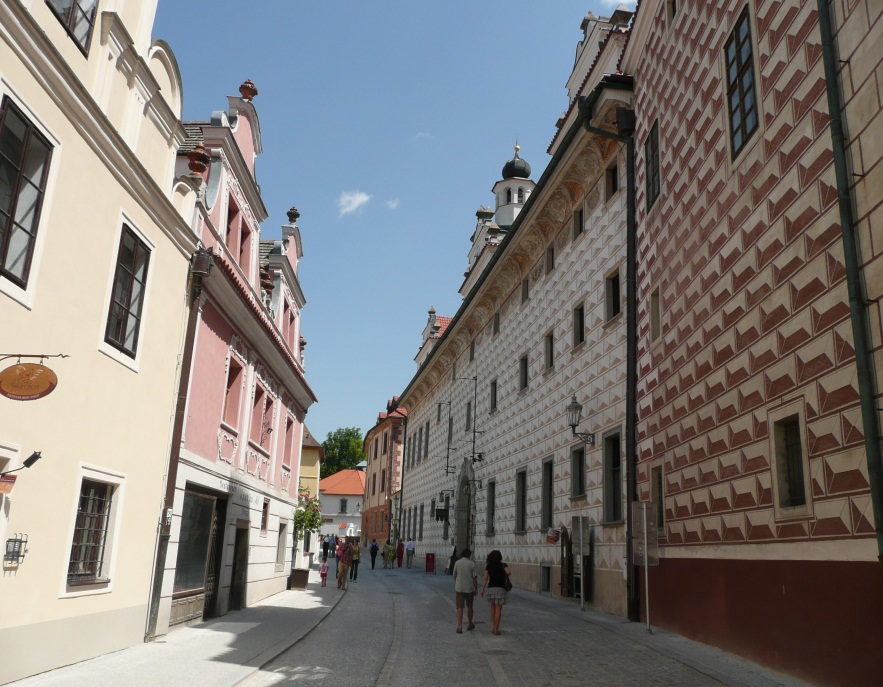
Cesky Krumlov, Czech Republic
If there is a distinctive division, where does east and west meet? There is an ancient invisible line from Gdansk in the north to Trieste in the south that separates the two parts with remarkable continuity from the eastern border of the Carolingian Empire to the frontier between the Austrian and Hungarian part of the Habsburg Empire to the western border of “real existing socialism” after 1947. From the Dalmatian coast to Lithuania there is a line dotted with fortresses, frontier settlements, strategic towns and historic cross roads. For centuries this area has been a point of encounters of Germans and Slavs, Austrians and Turks, Catholics and orthodox Christians. But it falls across a terrain, where peoples for centuries have met, mixed and fought. Contrary to other areas in Eastern Europe, Bohemia was until 1948 a flourishing component in the Industrial Revolution, which marked the western part off from the rest of the continent more than anything else, and it was firmly settled in the western European culture.
Is there a “Central Europe”? The geographical position is not clearly defined, but it would denote a quadrilateral from Riga to Prague down to Trieste and Zagreb and back to Lvov and the Baltic states. This area has much in common. It is predominantly catholic, rural, majority Slav speaking, characterised by outstanding towns and cities with unmistakable European architecture and heritage and a European cultural and literary tradition. In addition distinctive traditions of its own had developed over the centuries and an influential intelligentsia dominated the intellectual life since 1848. All this differentiates Central Europe remarkably from the lands to the east and south. “Central Europeans” of this area place much emphasis upon the ancient division between the Western and Eastern Roman Empires which leaves them well in the west. The idea of Central Europe came into existence with political and economic reforms of enlightened despots, especially Joseph II of Austria, who made possible the assimilation of Jews, and Friedrich II of Prussia. This blooming multi-cultural region was destroyed by the Versailles peace treaty in 1919 and the national divisions created then. Hitler administered the death blow. The “Golden Time” of Central Europe were the last decades of the Habsburg Empire when Prague, Krakow, Budapest, Lvov, and Zagreb flourished. However, the distinction that existed between Central and Eastern Europe was by no means clear to the West.
Central Europe was more or less the civilisation of the cities of “Habsburgia”, a cosmopolitan culture, often written and spoken in a then international language, namely German. Many of the most accomplished representatives were Jews. The destruction of this genuinely Central European culture has left the cities as provincial towns, their claim as to being distinctive Central European is sometimes viewed as nostalgic in the West. Their desire not to be confused with the people east of this important divide has deep historical roots as “frontier people”. This frontier has shifted over the centuries, but the most distinguishing feature remained, the division between rural and urban societies. The largely rural eastern and south-eastern parts of Europe fell far behind the urbanised north-west.
The north-west was formed into recognised nations and permanent states in earlier centuries, whereas the nation states in the east and south east were formed after the collapse of the Austrian, German, Russian and Turkish empires at the beginning of the 20th century. The area was characterised by an all or nothing claim to territory and power at the expense of a neighbour making an identical claim. This resulted in the great misfortune of Eastern Europe. The division into states came late and all at once. Germany and Italy also united late, but overcame that disadvantage. The intelligentsia of Eastern Europe has always striven to associate with the West, especially with France. Francophilia was especially wide-spread among Polish, Romanian and Serb intellectuals in the 19th and early 20th century. Yet their efforts to identify with Western European culture were met by a gulf of disinterest and misunderstanding. As a result the cosmopolitan elite was further alienated from the masses of the people and this provoked hyper-nationalism among local leaders. In fact, countries west of the rivers Elbe and Leitha have always been seen as European, the countries east of that divide have always been in the process of “becoming European”. The enlargement of the European Union to the east and south-east represents a special challenge to the existing set of European policies. But despite all adversities it presents political opportunities for creating a peaceful, democratically governed and economically efficient Europe that finally puts an end to the legacies of World War I and II and in the long run will overcome the ancient division line between east and west.
Literature: Judt, Tony, A Grand Illusion? An Essay on Europe, Penguin 1996
